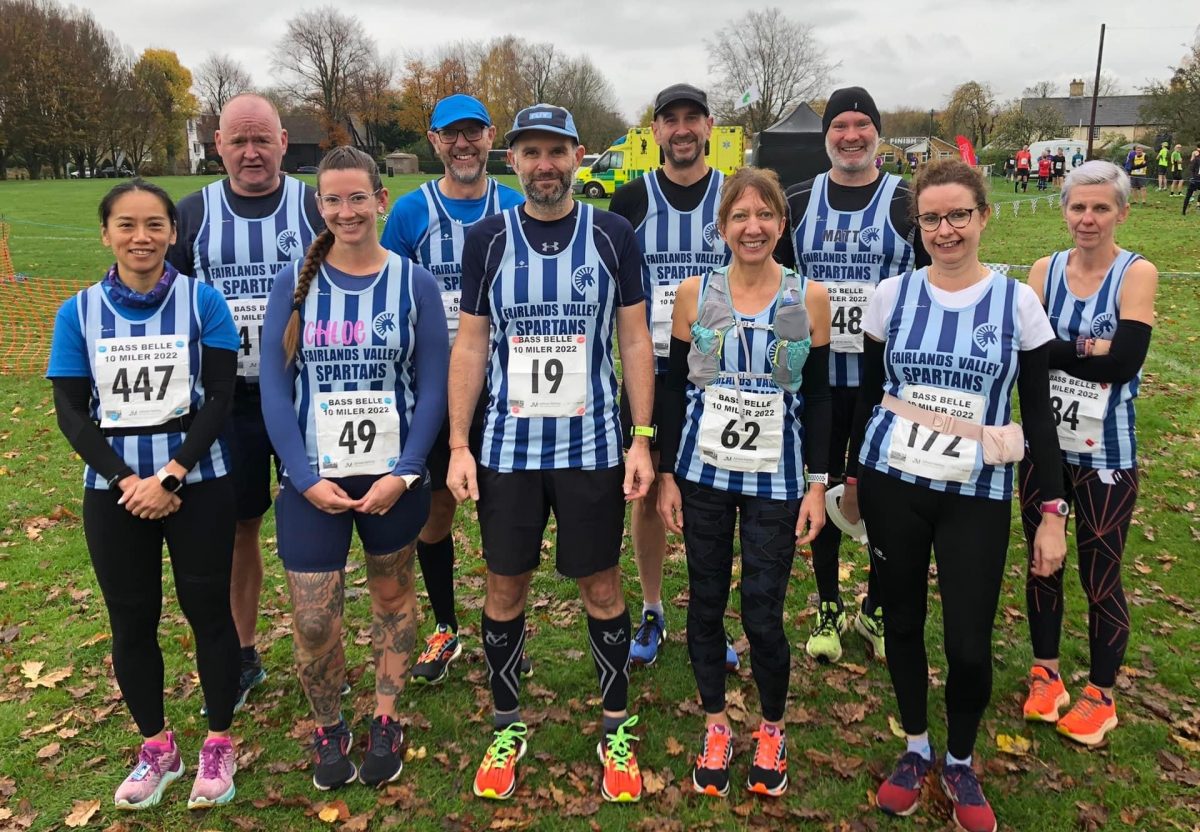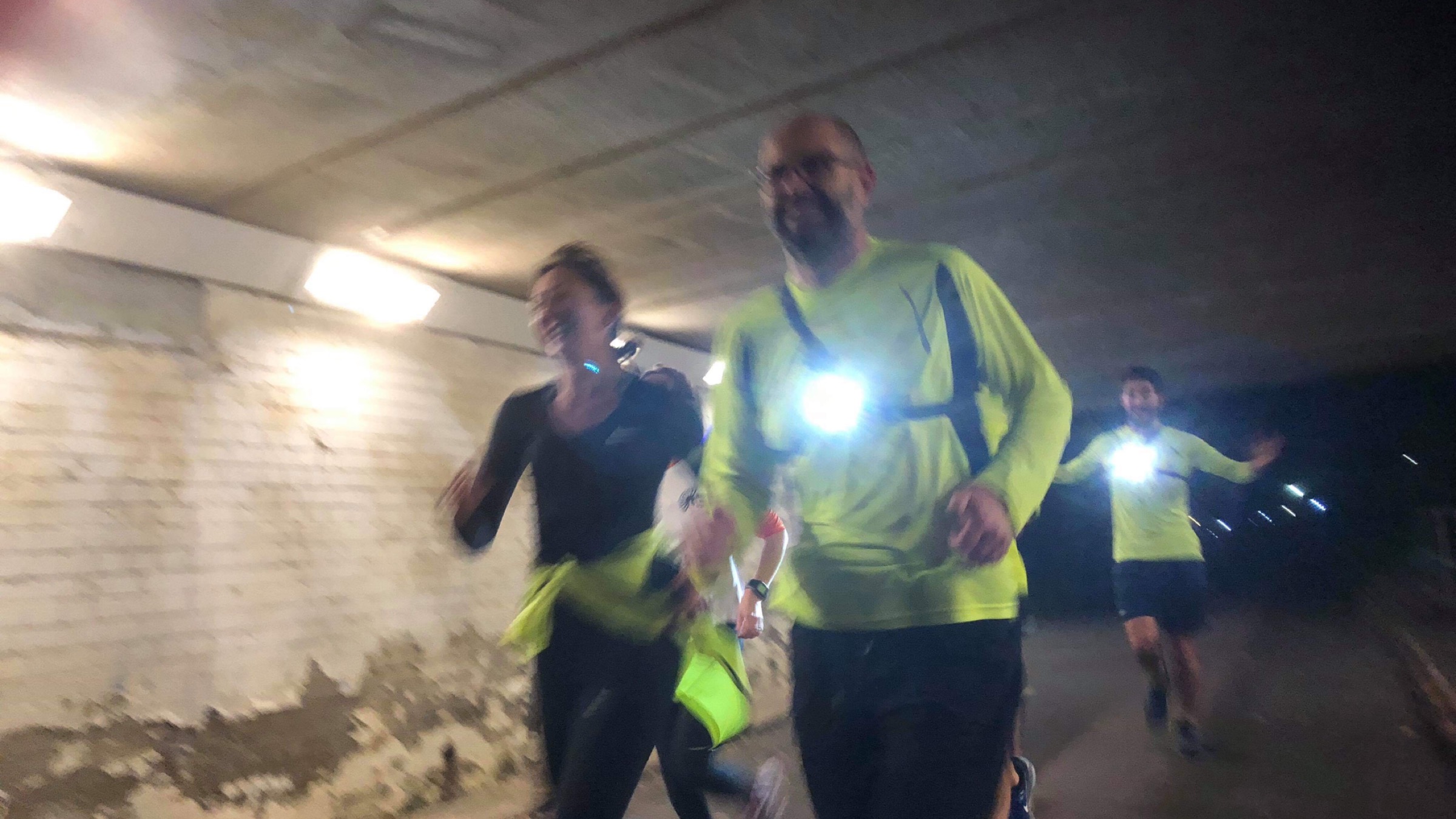Hatfield 5 Wins
Fairlands Valley Spartans came home with GOLD, SILVER and BRONZE from the Hertfordshire County Five Mile Championships for veterans which were incorporated in the Hatfield Five on Sunday morning.
GEORGIE HOOPER (35:32 – a personal best PB by 11 minutes 39 seconds!); MARIE COLUCCI (37:18 – a season’s best SB by 3:01) and YUKO GORDON (37:42) won BRONZE in the women’s team competition.
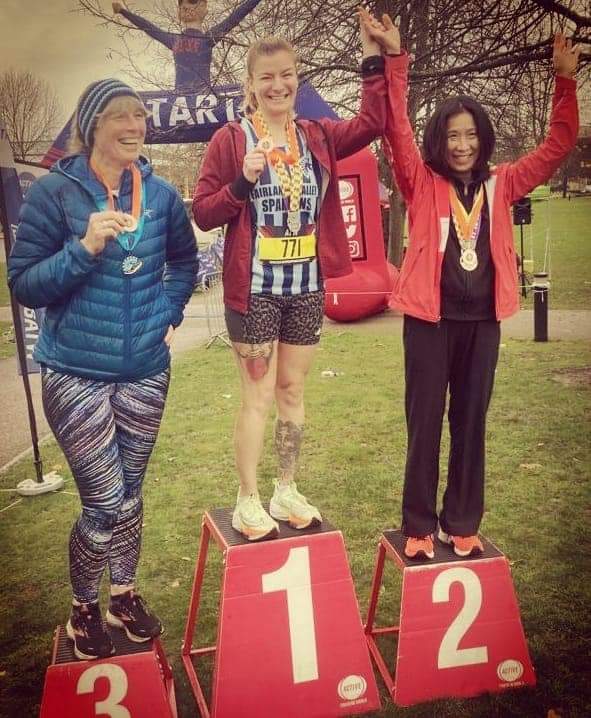
Yuko took individual SILVER in the championship for women aged 65 plus.
The GOLD medal went to JIM BROWN who won the county championship for men aged 70 plus with exactly two minutes to spare in a year’s best (YB) time of 42 minutes 39 seconds.
Good fast five-mile races are pretty rare, and 22 Spartans took the opportunity. There were some outstanding performances in the open race as well as the county event. Every single Spartan that ran achieved a milestone. NICK GILL was fastest from Fairlands, 53rd out of the 655 finishers in 30 minutes 50 seconds – an outstanding personal best by 16 minutes 21 seconds.
SAM SIMMONS improved his PB by 4:13 to 33:40. PETE SMITH took 3:05 off his SB to 35:12. SUSAN McANENY reduced her PB by five seconds to 39:27 and NICK KLEANTHOUS by 58 seconds to 42:19. NICOLA ANDERSSON sliced 1:17 off her life-time best with 43:38 and PENNY SCHENKEL improved her SB by 1:42 to 45:14.
MATT TUTTON took 37 seconds off his PB with 46:46 and JANE WADEY ran the PB bell with her new personal best of 52 minutes 26 seconds. An improvement of 1:48.
SHARON CROWLEY took her season’s best down by 52 seconds to 55:03 and BRIAN WHITE, JONATHAN JONES and DZENANA TOPIC ran their best five-mile times this year with 36:51; 56:55 and 57:40.
Three Spartans were running their first ever five-mile races – MIKE JEFFS in 35:32; MARCUS RIDLEY in 37:34 and HARRIET SMITH 38:59.
MARK GOODWIN equalled his five-mile time with 37:34 and DANNY SCANLON was in the top 100 with a year’s best time of 32:49.
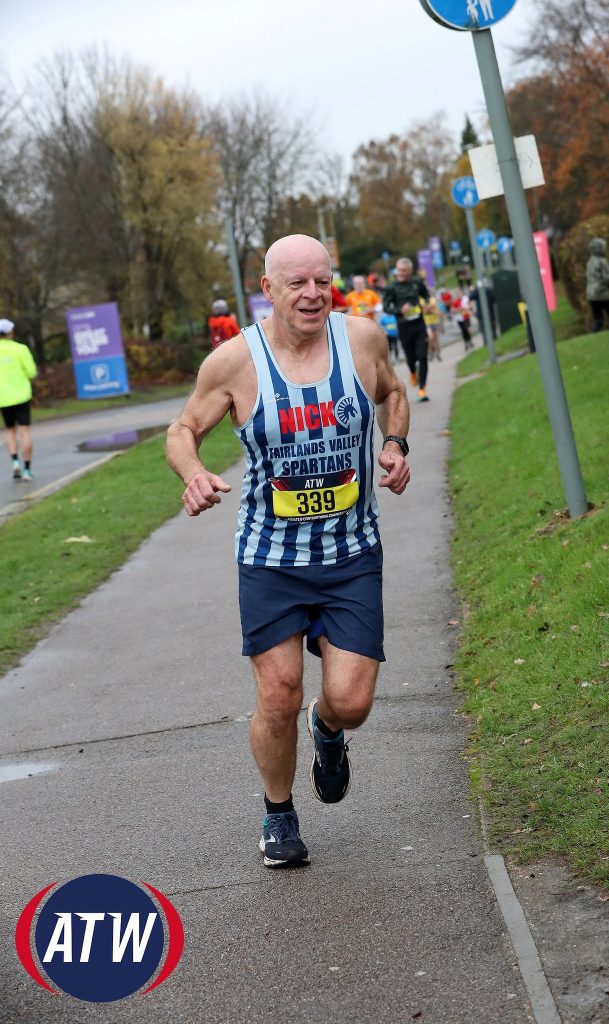
Bests At Bass Belle Ten
Another ten Spartans were at the Bass Belle Ten, a partly off-road event based in Bassingbourn.
STEVEN DOBNER said “Rain greeted us but luckily had passed through before the start. After setting an unofficial PB in last week’s half marathon in Gosport I had a time to aim at and felt comfortable throughout. Starting quickly to find some space and to try to get the best of the tricky 1.5miles muddy and slippery off-road section in road shoes, we settled into our rhythm ticking off the kilometers and judging the effort. The little hill proved less of an obstacle this year and I was very happy to come home in a time of 1:15:05, knocking 5 minutes 31 off my previous best 10-mile race.”
DAVE PATTMAN also came home with a new personal best of 1:15:41 shaving 2 minutes off his PB. MO WARRILOW said she enjoyed the run, finished with a smile on her face and beat 90 minutes by 22 seconds.”
PAUL and ALISON SHELLEY ran Bass Belle again and said as always it was well organised and well supported. The 1:5 mile off road section was a bit tricky but otherwise a nice route. It was great to see so many Spartans.
Paul was 27th 1:11:35 – 27th overall. Alison finished in 1:27:41.
The other Spartans were MATT CLARKE 1:25:11; MICHAEL O’KEEFE 1:35:00 in his first ten-mile race; FIONA CLARKE 1:37:39; CHLOE CHAPMAN 1:37:53 and MONICA SMITHSON 1:51:24.
Serpentine
Runners were so lucky with the conditions again for the Serpentine Last Friday of the Month 5K in Hyde Park, London. It was sunny, mild and with a light breeze for the lunch-time event. JIM BROWN ran his best 5K of the year with 26 minutes 8 seconds and second in his age category.
Canicross
TRACY PEZ (and her dog) enjoyed a Canicross event at Grafham Water which they completed in 1 hour 21 minutes 7 seconds.
Parkrun Highlights 26th November 2022 – Penny in the Cape
Numbers were back over 300 for the 266th Stevenage with 314 completing the 5K Saturday morning run in Fairlands Valley Park. 24 were Spartans.
In Stevenage PENNY SCHENKEL ran her 50th parkrun in the red celebration cape with a time of 30 minutes 49 seconds. MATTHEW NEWTON ran new PB of 20:14. ADRIAN BUSOLINI was 3rd overall in 18:15 and GRANT RAMSAY 4th in 18:58.
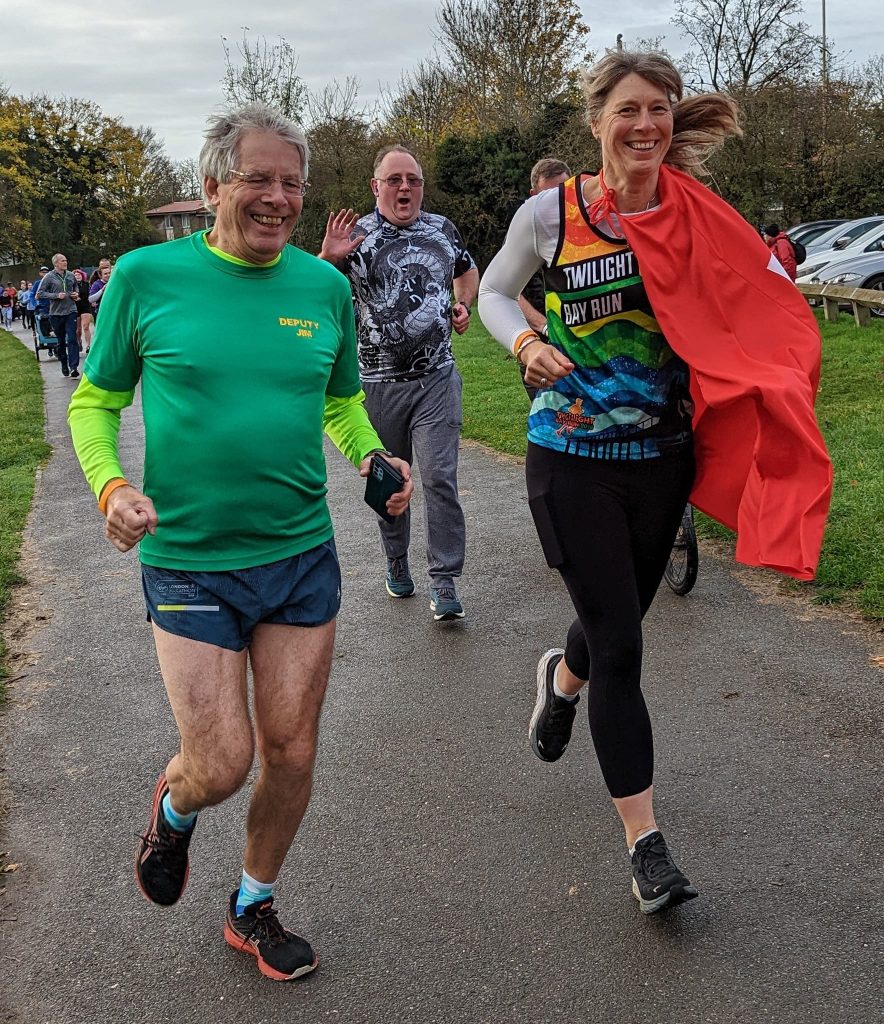
Elsewhere DARRYL STEVENS continues his tour of many different parkruns. He was a first timer at Eastville, Bristol and finished in 39:30. MATT and FIONA CLARKE were first timers at Lee-on-the-Solent, Hampshire with 31:07 and 31:11.
JULIET FULLWOOD was a first timer at Alexandra, Moss Side in Manchester on her first parkrun. She was fourth women in 21:59.
22 Spartans at the Hatfield Five:
| Position | Name | Net Time | Open Category | Cat Pos | Gender | Gen Pos | Comments |
| 53 | Nick GILL | 30:50 | Senior | 24 | Male | 49 | PB (16:21) |
| 86 | Danny SCANLON | 32:49 | M40 | 30 | Male | 75 | YB (year best) |
| 106 | Sam SIMMONS | 33:40 | Senior | 37 | Male | 92 | PB (4:13) |
| 138 | Peter SMITH | 35:12 | M60 | 8 | Male | 120 | SB (3:05) |
| 152 | Mike JEFFS | 35:32 | Senior | 50 | Male | 133 | First 5 miles |
| 153 | Georgie HOOPER | 35:32 | Senior | 4 | Female | 19 | Team Bronze. PB (11:39) |
| 181 | Brian WHITE | 36:51 | M60 | 14 | Male | 151 | YB |
| 205 | Marie COLUCCI | 37:18 | W40 | 10 | Female | 33 | Team Bronze. SB (3:01) |
| 210 | Yuko GORDON | 37:42 | W70 | 1 | Female | 35 | County Silver. Team Bronze. YB. |
| 211 | Marcus RIDLEY | 37:34 | Senior | 61 | Male | 175 | First five miles |
| 213 | Mark GOODWIN | 37:34 | M60 | 17 | Male | 177 | SB (equal) |
| 242 | Harriet SMITH | 38:59 | Senior | 12 | Female | 41 | First five miles |
| 266 | Susan MCANENY | 39:27 | W40 | 17 | Female | 54 | PB (0:05) |
| 317 | Nick KLEANTHOUS | 42:19 | M60 | 24 | Male | 230 | PB (0:58) |
| 334 | Jim BROWN | 42:39 | M70 | 3 | Male | 239 | County Gold. YB |
| 354 | Nicola ANDERSSON | 43:38 | W50 | 27 | Female | 105 | PB (1:17) |
| 414 | Penny SCHENKEL | 45:14 | W50 | 36 | Female | 137 | SB (1:42) |
| 448 | Matt TUTTON | 46:46 | Senior | 80 | Male | 287 | PB (0:37) |
| 551 | Jane WADEY | 52:26 | W50 | 65 | Female | 227 | PB (1:48) |
| 587 | Sharon CROWLEY | 55:03 | W60 | 31 | Female | 257 | SB (0:52) |
| 596 | Jonathan Clive JONES | 56:55 | M50 | 95 | Male | 331 | YB |
| 604 | Dzenana TOPIC | 57:40 | W50 | 84 | Female | 271 | YB |
PB = personal best (lifetime); SB = season’s best; YB = year’s best. 655 finishers.
10 Spartans at the Bass Belle:
| Position | Name | Time | Comments | BIB |
| 27 | PAUL SHELLEY | 1:11:35 | “SB” (2:50) | 61 |
| 52 | STEVEN DOBNER | 1:15:04 | “PB” (5:30) | 19 |
| 56 | DAVE PATTMAN | 1:15:41 | “PB” (1:50) | 20 |
| 126 | MATT CLARKE | 1:25:11 | “YB” | 448 |
| 140 | ALISON SHELLEY | 1:27:41 | “SB” | 62 |
| 164 | MO WARRILOW | 1:29:38 | “SB” (6:15) | 84 |
| 206 | MICHAEL O’KEEFE | 1:35:00 | First 10 miles | 418 |
| 235 | FIONA CLARKE | 1:37:39 | “YB” | 447 |
| 236 | CHLOE CHAPMAN | 1:37:53 | “PB” (6:19) | 49 |
| 313 | MONICA SMITHSON | 1:51:24 | “SB” | 172 |
356 finishers
24 Spartans at the Stevenage parkruns on Saturday 26th November:
| Position | Gender Position | parkrunner | Run Time | |
| 3 | 3 | Adrian BUSOLINI | 00:18:15 | Top ten |
| 4 | 4 | Grant RAMSAY | 00:18:58 | Top ten |
| 11 | 10 | Matthew NEWTON | 00:20:14 | |
| 32 | 29 | Paul SHELLEY | 00:22:08 | |
| 54 | 47 | Martin DUDLEY | 00:23:58 | |
| 89 | 12 | Gail MACKIE | 00:25:43 | |
| 90 | 75 | Toby ECCLESHALL | 00:25:44 | |
| 95 | 78 | Neal MUGGLETON | 00:26:08 | |
| 99 | 81 | Michael O’KEEFE | 00:26:15 | |
| 100 | 82 | Steven DOBNER | 00:26:16 | |
| 108 | 17 | Mo WARRILLOW | 00:26:41 | |
| 109 | 87 | David PATTMAN | 00:26:42 | |
| 134 | 107 | Thomas SAUKA | 00:27:47 | |
| 161 | 121 | Nick KLEANTHOUS | 00:29:03 | |
| 162 | 33 | Alison SHELLEY | 00:29:05 | |
| 169 | 39 | Chloe CHAPMAN | 00:29:12 | |
| 170 | 123 | Sam SIMMONS | 00:29:13 | |
| 179 | 43 | Nicola ANDERSSON | 00:29:41 | |
| 194 | 139 | Jim BROWN | 00:30:48 | |
| 195 | 47 | Penny SCHENKEL | 00:30:49 | 50th parkrun in the cape |
| 203 | 53 | Nikki Katherine NATION | 00:31:08 | |
| 234 | 71 | Sheryl HANN | 00:33:42 | |
| 257 | 163 | Stephen SMITHSON | 00:34:55 | |
| 264 | 84 | Samantha SUTTON | 00:35:56 |
314 finishers.

